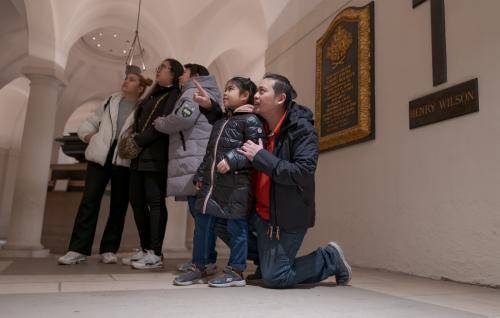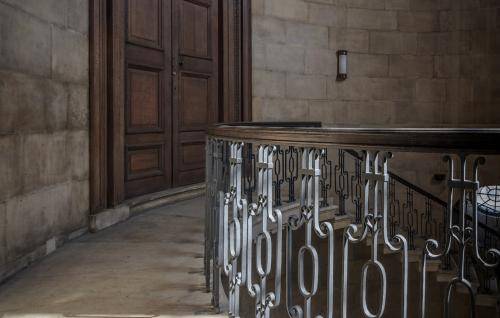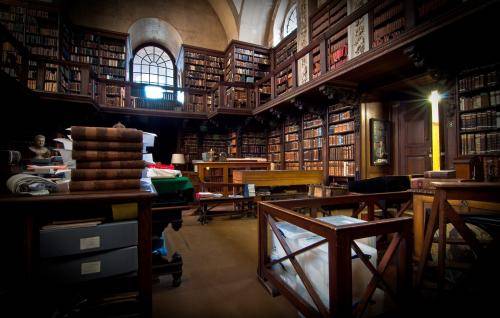Explore our map
Select floor
Cathedral Floor

The Font
Despite its elaborate appearance, the Font’s purpose is simple – to hold water used in the ceremony of baptism. Baptism celebrates the beginning of a Christian’s spiritual journey and the Font is positioned near the west entrance – to welcome visitors into the home and family of the Christian Church.
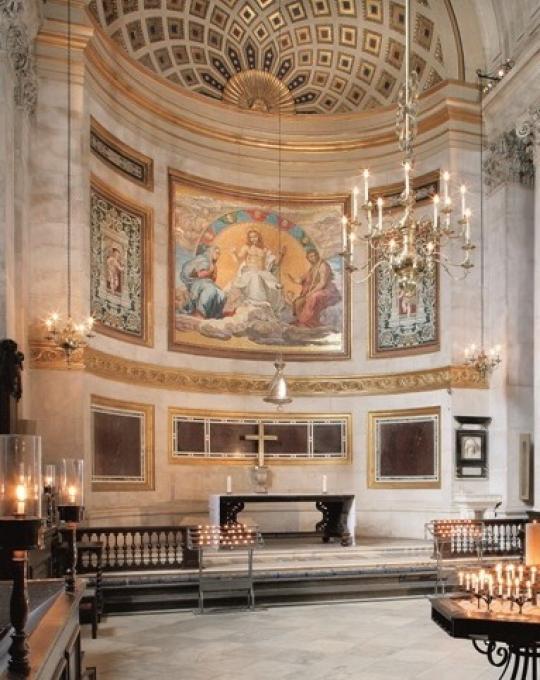
St Dunstan's Chapel
St Dunstan's Chapel, consecrated in 1699, was the second part of Wren's building to come into use, after the Quire. The chapel is set aside for prayer throughout the day. You can light a candle here or leave names of those whom you would like to be prayed for during one of our services.
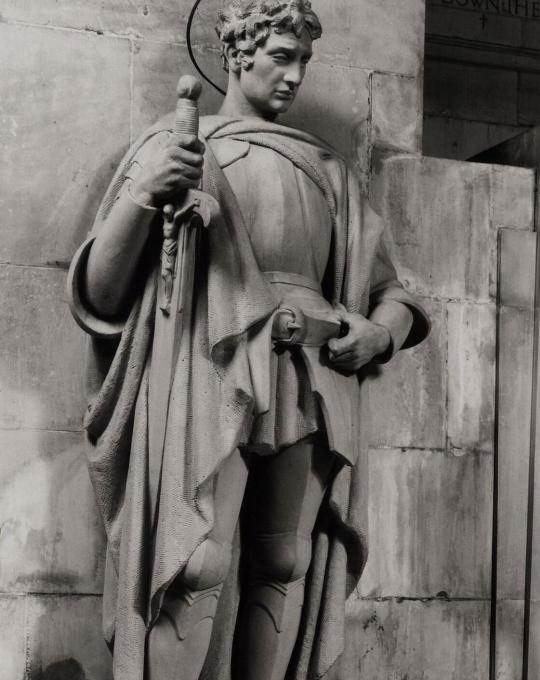
All Souls' Chapel
This chapel in the north tower was dedicated in 1925 to the memory of Field Marshal Lord Kitchener. Kitchener died at sea and his body was never recovered. He is known for his restructuring of the British army during World War One and for the most effective recruitment campaign in British military history, using the slogan 'Your Country Needs You'.
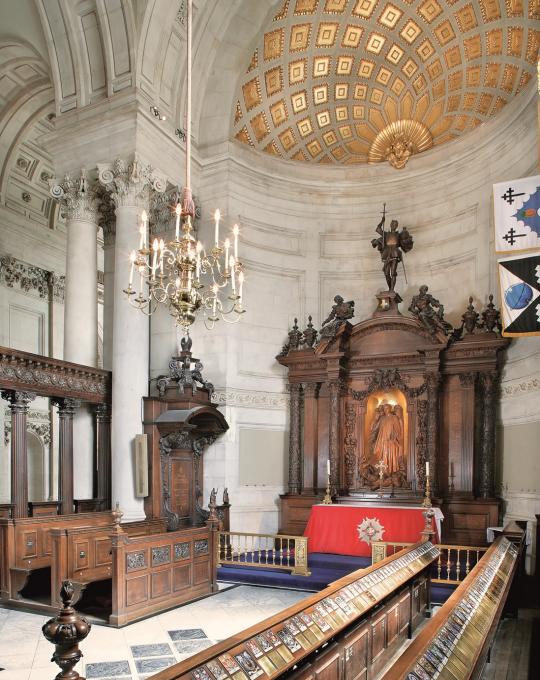
The Chapel of St Michael and St George
This chapel was originally a consistory court in which cases of ecclesiastical law were heard. Dedicated in 1906 to St Michael and St George, its stalls feature banners of current knights and officers of the Order of St Michael and St George, including HM The Queen, who visits periodically for the Order's ceremonial service.
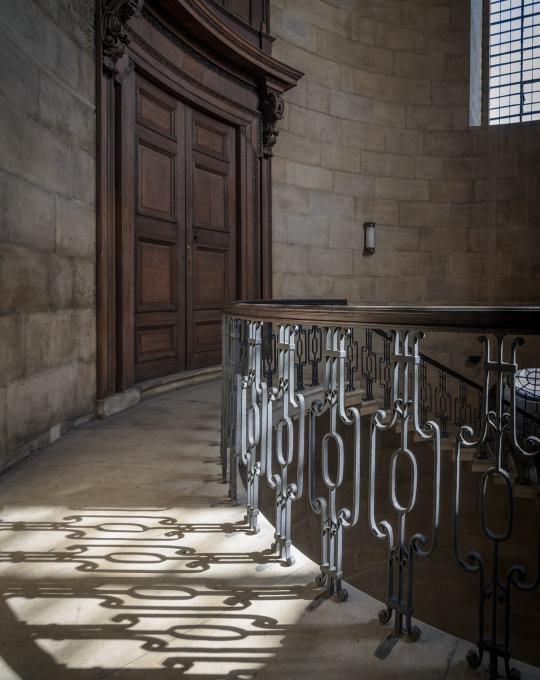
The Geometric Staircase
Hidden away in the south west bell tower, the Geometric Staircase is a wonder of design, with its steps appearing to float up to the ceiling without support. The staircase was made famous when it was used as the route for young wizards to get to their divination class in the Harry Potter film franchise.
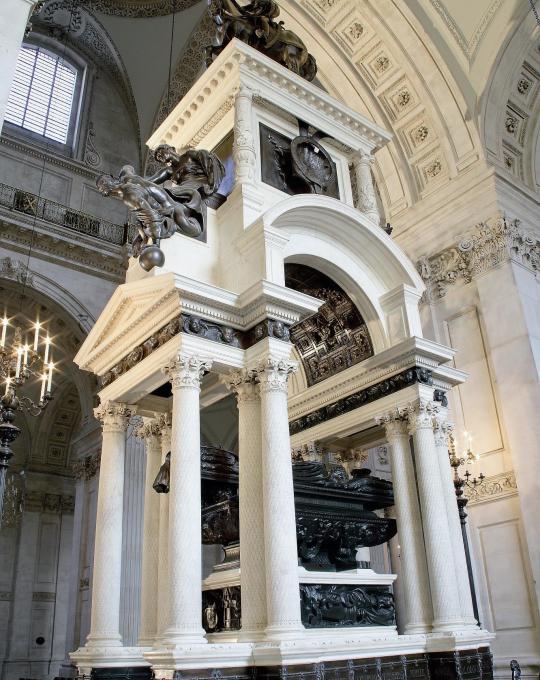
The Wellington monument
A monument to one of Britain's greatest soldiers and statesmen, Arthur, Duke of Wellington, sits in an arch between the Nave and North Aisle. Wellington died in 1852 but his monument was not completed until 1912, when the figure on horseback was unveiled.
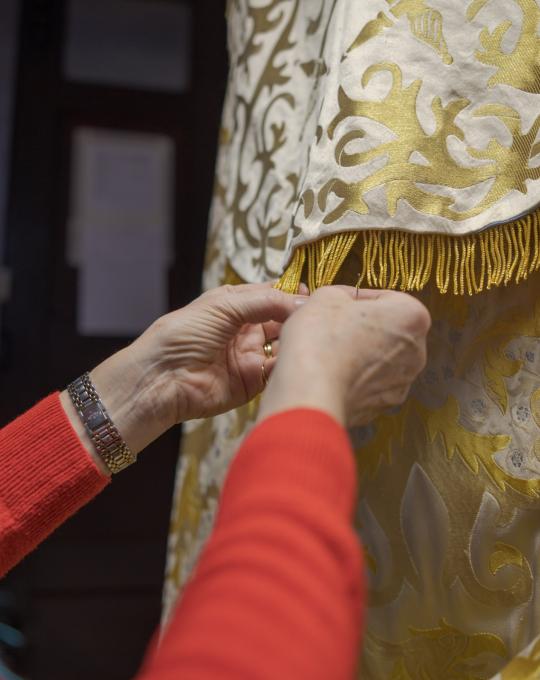
Highlights from the textile collection
A beautiful embroidered textile on display on the Cathedral Floor dates from around 1897 and is an altar frontal – made to decorate the front of an altar. It was made by Watts & Co and possibly designed by Cecil Hare working with G.F Bodley. It is decorated with images of St Peter, Christ and St Paul.

The Middlesex Chapel
The Chapel of St Erkenwald and St Ethelburga – also known as the Middlesex Chapel – is a place for prayer, reflection and remembrance. Since March 2022, it has had a special focus on remembering those lost to the COVID-19 pandemic, and features podiums showing our virtual book of remembrance – part of our Remember Me project.
The Dome altar
The altar under the Dome is used for the daily celebration of the Eucharist. This area is the natural heart of the building, the centre of worship today and a good example of how the Cathedral continues to evolve. For many years, services were only held in the Quire. Now, with an altar permanently located here, services look and feel much more welcoming.
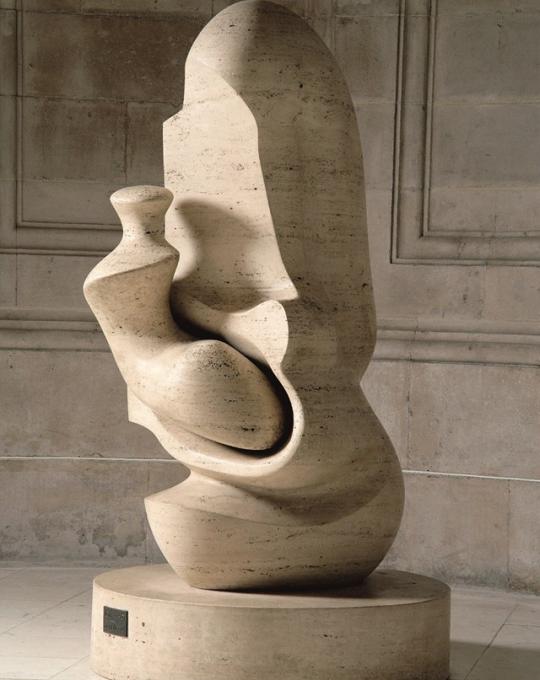
Mother and Child:hood by Henry Moore
The first piece of contemporary art to be housed by the Cathedral, Moore's Mother and Child:hood arrived in 1983, and was the artist's last large-scale work. Made specifically for its location in the Minor Canons’ Aisle, the work presents three stages of motherhood: conception, gestation and parenting.
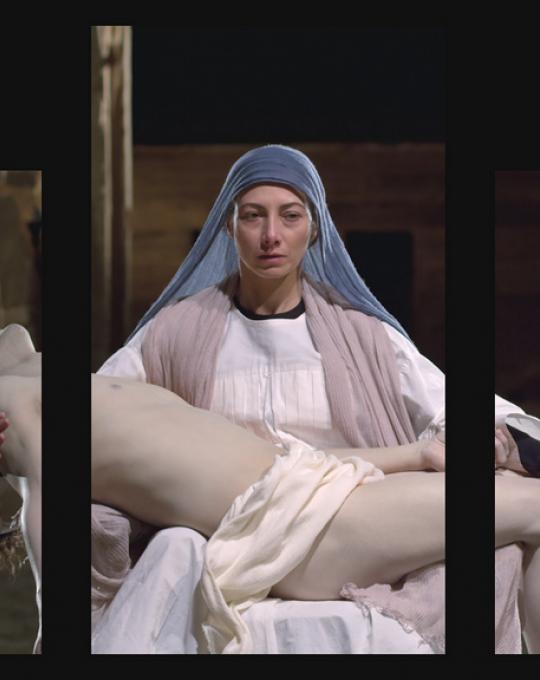
Mary by Bill Viola
Mary is the second video work by Bill Viola to be featured in the Cathedral, joining its sister Martyrs in October 2016. A much less disquieting piece than its counterpart, it is also comprised of vertical video screens, showing rich depictions of the life of the Mother of Christ.
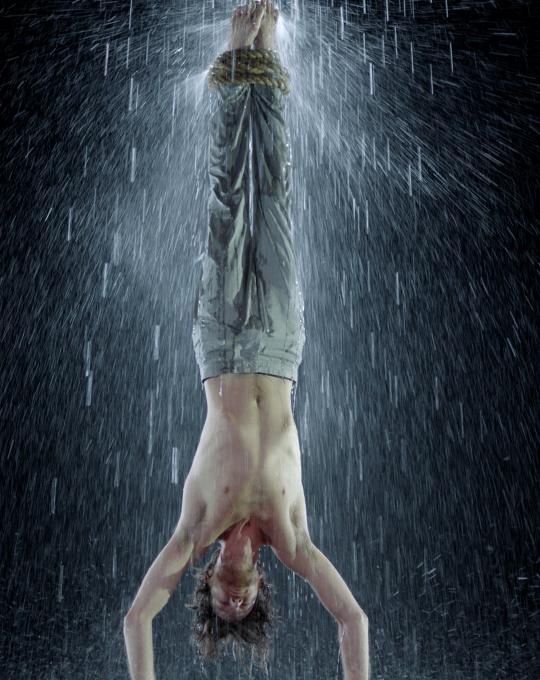
Martyrs by Bill Viola
Martyrs opened in May 2014, and is one of two video works on loan from the Tate Modern, both created by Bill Viola and his collaborator and partner Kira Perov. This challenging, soundless work shows four individuals across four colour vertical plasma screens being martyred by the classical elements – earth, air, fire and water.
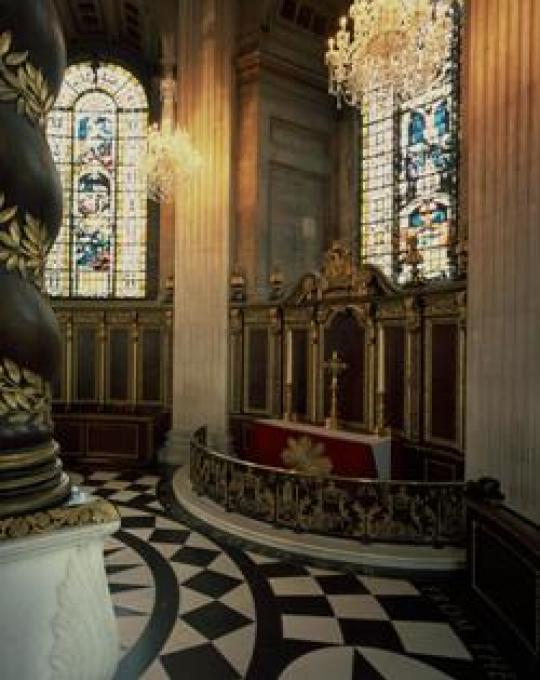
The American Memorial Chapel
The American Memorial Chapel is also known as the Jesus Chapel. This part of the Cathedral was destroyed during the Blitz. During restoration, it was made to commemorate the 28,000 Americans in the UK who died during WWII. The images that adorn its wood, metalwork and stained glass include depictions of the flora and fauna of North America.
The High Altar
The current High Altar dates from 1958 and is made of marble and carved and gilded oak. It features a magnificent canopy based on a sketch by Christopher Wren, but which wasn't built in his time. It replaced a large Victorian marble altar and screen, which were damaged by a bomb strike in WWII, which destroyed a large part of the east end of the Cathedral.
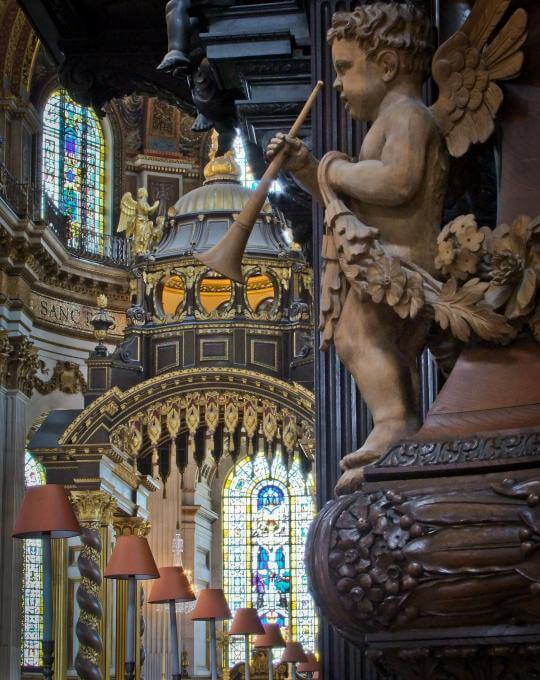
The Quire
The Quire is where the choir and clergy normally sit during services, and was the first part of St Paul's to be built and consecrated. The stalls on both sides feature delicate carvings by Grinling Gibbons, whose work is seen in many royal palaces and great houses. The Bishop's throne, or cathedra, sits in the Quire.
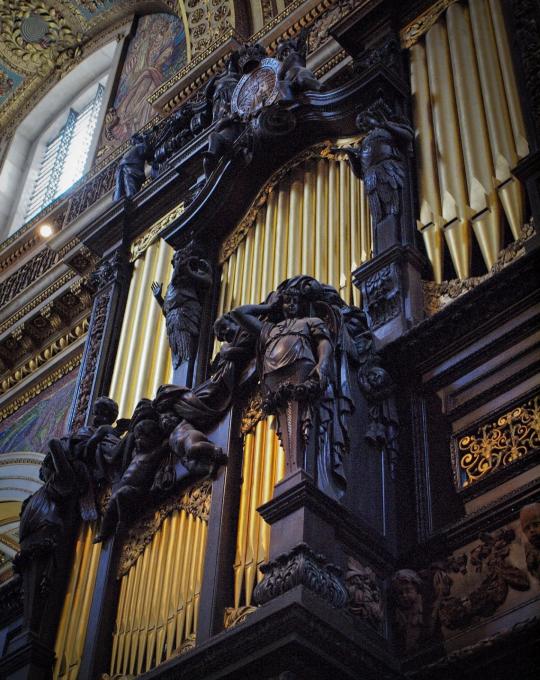
The Grand Organ
The Grand Organ was built and installed in 1695 and has seen several restorations since. Its case, by Grinling Gibbons, is one of the Cathedral's greatest artefacts, and once formed a screen keeping the Quire separate from the Nave and Dome areas. The third largest organ in the UK, it has 7,189 pipes, five keyboards and 138 organ stops.
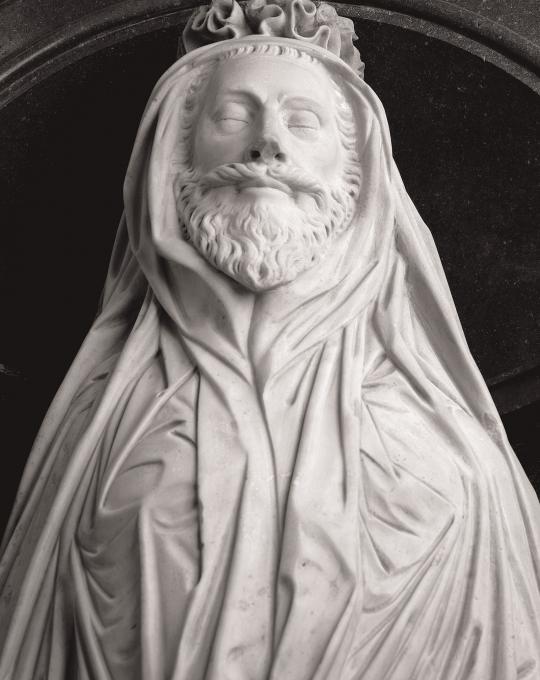
Effigy of John Donne
John Donne lived many lives before becoming Dean of St Paul's in 1621; as husband, father, lawyer, soldier, politician, poet and priest. His funeral effigy was the only monument to escape significant damage during the Great Fire of London. Sculpted by Nicholas Stone, the story goes that a dying Donne posed for the artist wrapped in a shroud.
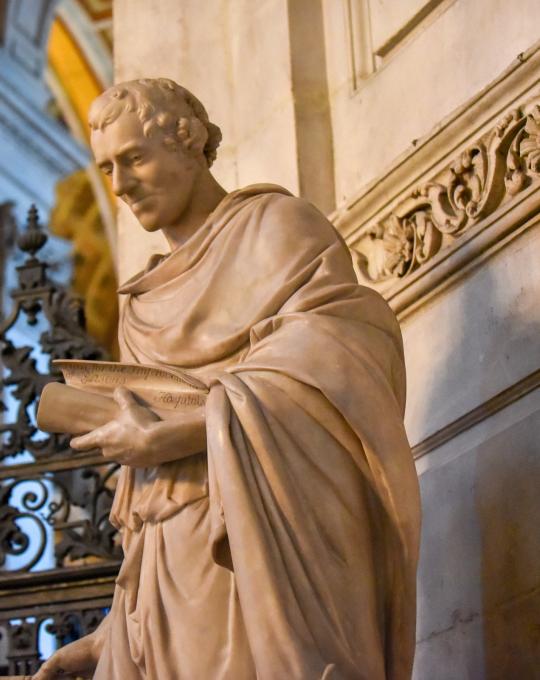
John Howard's monument
Prison reformer John Howard travelled Britain and Europe in the 1700s, studying prison conditions and campaigning for change. Howard’s monument, sculpted by John Bacon the Elder, was the very first to be introduced into the Cathedral in 1795, 80 years after the building was completed.
Cathedral Floor





The Crypt
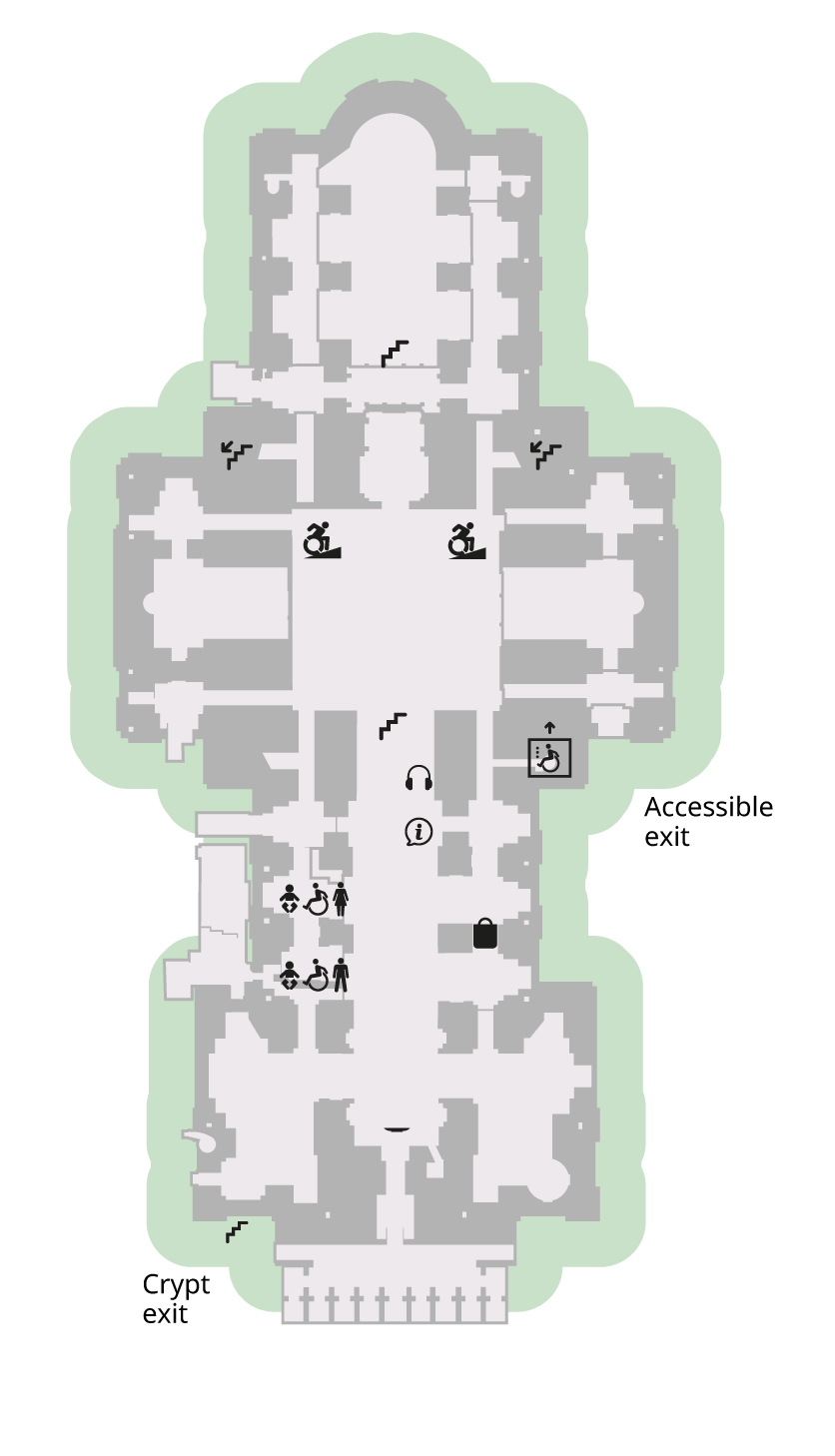
Musician's memorials
This area of the Crypt is where well-known musicians, together with former Cathedral organists and choir masters, have been laid to rest and memorialised. These include composers Hubert Parry and Sir Arthur Sullivan, and in another area of the Cathedral Crypt, a memorial to Welsh composor and actor Ivor Novello.
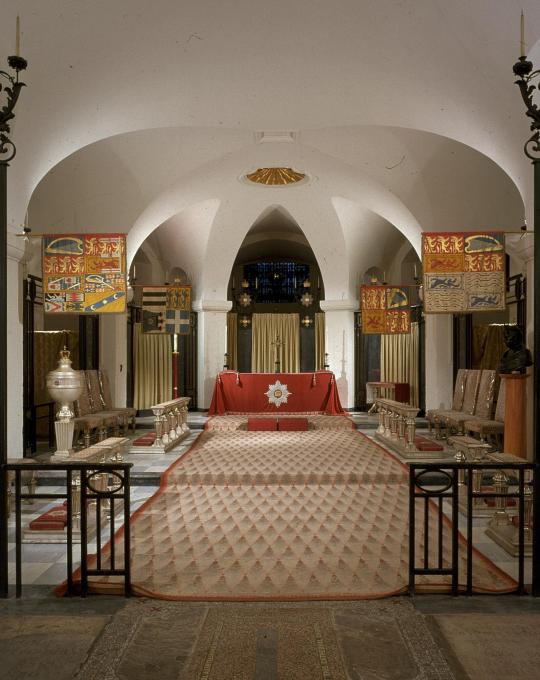
The OBE Chapel
The OBE Chapel, also known as St Faith's Chapel, was originally a parish church attached to the old Cathedral destroyed in the Great Fire of London. In 1960, this chapel became the spiritual home of the Order of the British Empire (OBE), an honour created by King George V in 1917, to recognise the considerable civilian contribution to World War One.
Artists' memorials
Many prominent artists and sculptors of the 1700s onwards are buried close together in this area of the Crypt. There are also memorials to artists who are laid to rest in places other than St Paul's, and artists whose tombs and memorials were lost when the Great Fire of London destroyed the medieval Cathedral.
William Blake's memorial
A memorial to William Blake by H. Poole was unveiled at St Paul's in 1927 to mark the centenary of Blake's death. Blake was an artist, poet, printmaker, mystic and radical activist, and in many ways so ahead of his time that he was largely unappreciated during his lifetime.
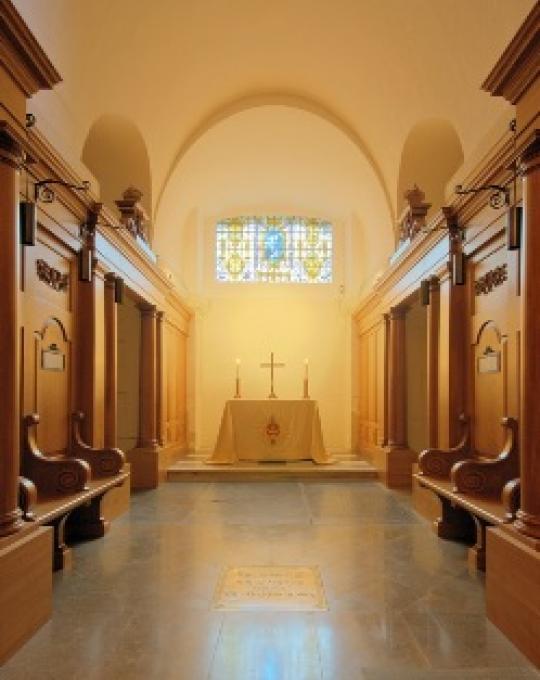
The Knights Bachelor Chapel
This chapel is also known as St Martin's Chapel. It is panelled with English oak and contains two elegant cases, with registers featuring the names of all Knights Bachelor (deceased) from 1257 to date, in addition to the Founder Knights' and Benefactors' Book. Near them is displayed Queen Victoria's sword, with which she knighted many famous men.
Sir Christopher Wren's tomb
The tomb of Sir Christopher Wren, the architect of St Paul's, is marked by a simple stone and is surrounded by memorials to his family, to his collaborator Robert Hooke and to the masons and other colleagues. The Latin epitaph above his tomb, famously addresses us: 'Reader, if you seek his monument, look around you.'
Scientists' memorials
Scientists' memorials in the Crypt are grouped closely together and include pharmacist and philanthropist Sir Henry Wellcome, physician and microbiologist Alexander Fleming, who discovered penicillin, and Gordon Hamilton-Fairley, the first professor of medical oncology.
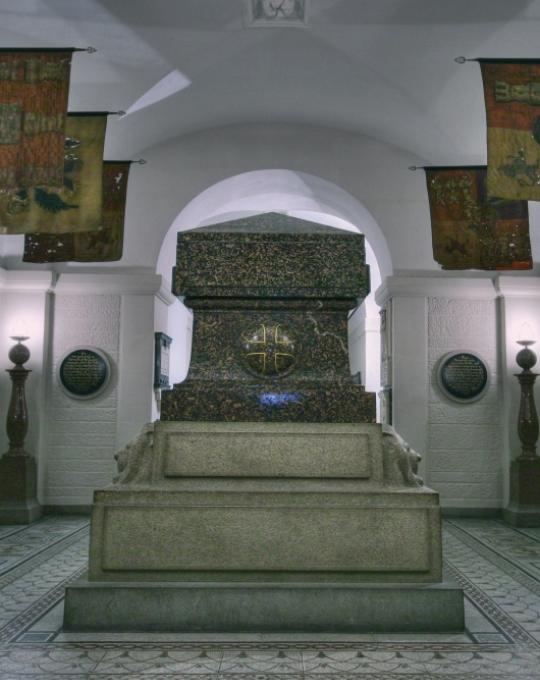
Wellington's tomb
Wellington rests in an imposing casket made of Cornish granite. Although a national hero, he was known as The Iron Duke and – as a result of his tireless campaigning – had a colourful list of namesakes: Wellington boots, the dish Beef Wellington and even a brand of cigars. The banners hanging around Wellington's tomb were made for his funeral procession.
Falklands memorial
On June 14th 1985, the third anniversary of Britain's victory during the Falklands War, Queen Elizabeth II unveiled a memorial in the Crypt to the 255 British people who were killed during the 1982 conflict. The large slate tablet is located between the tombs of Admiral Lord Nelson and the Duke of Wellington.
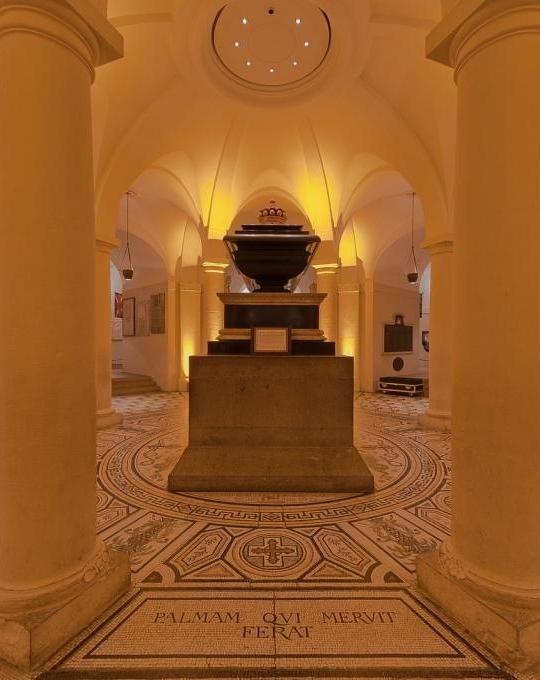
Nelson's tomb
Lord Nelson was killed in the Battle of Trafalgar in 1805 and his coffin was made from the timber of a French ship he defeated in battle. The black marble sarcophagus that adorns his tomb was originally made for Cardinal Wolsey, Lord Chancellor during the reign of Henry VIII – until Wolsey fell from favour.
Florence Nightingale memorial
Florence Nightingale was the founder of modern nursing, a social reformer and a respected statistician. She became well known for her nursing efforts during the Crimean War, and later laid the foundations for the nursing profession at St Thomas’ Hospital in London. Although not buried at St Paul’s, she is commemorated with a marble memorial.
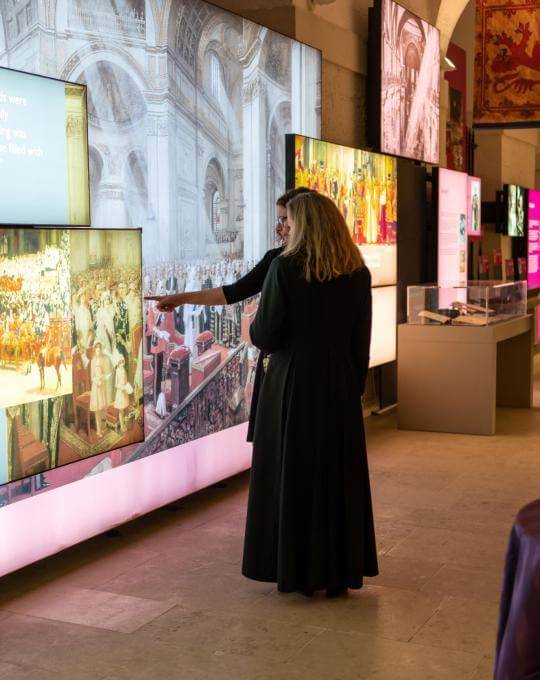
Exhibition space
Our current exhibition features archive material and objects from the Cathedral Collections, exploring the grand ceremonial occasions held at the Cathedral to commemorate the Royal Jubilees of four British monarchs: George III, Victoria, George V and Elizabeth II.
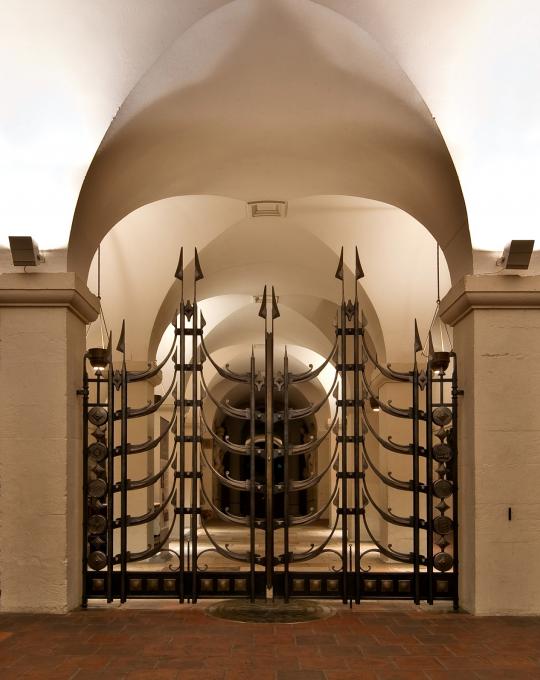
Winston Churchill memorial gates
Sir Winston Churchill is not buried at St Paul’s but his state funeral was held here in 1965. These ornate gates were installed to commemorate the event. This monument is also placed in line with the tombs of Wellington and Nelson – ranking Churchill alongside those towering figures of British history.
The Crypt






The Dome
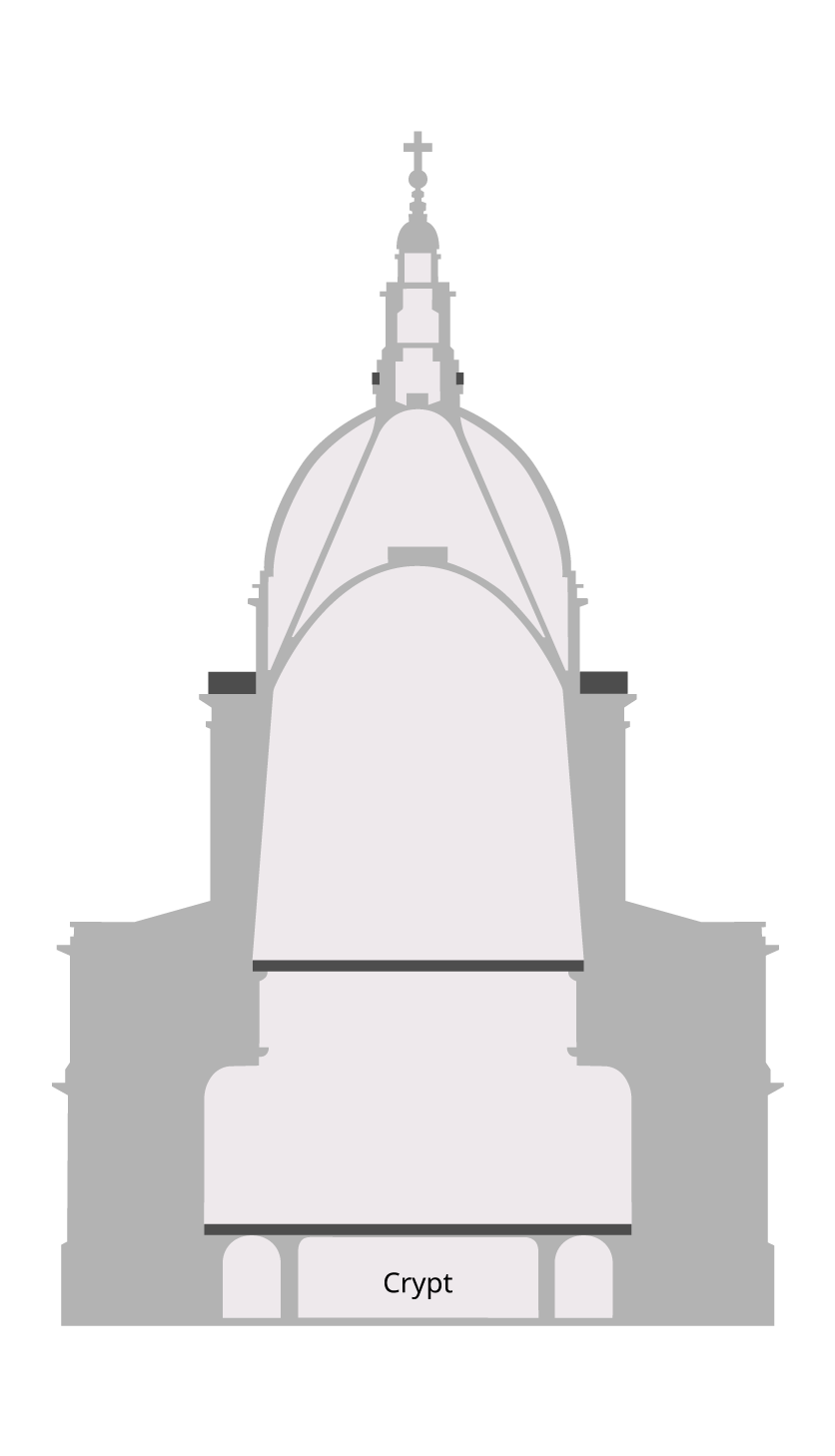
The Ball and Lantern
The original ball and cross that topped the Cathedral were erected in 1708. They were replaced by a new ball and cross in 1821, designed by the Surveyor to the Fabric, C R Cockerell. The ball and cross stand at 23 feet high and weigh approximately seven tonnes.

The Golden Gallery
The Golden Gallery is the smallest of the galleries and runs around the highest point of the outer Dome, at 85 metres. Visitors who climb the 528 steps to this gallery will be treated to incredible panoramic views of London.
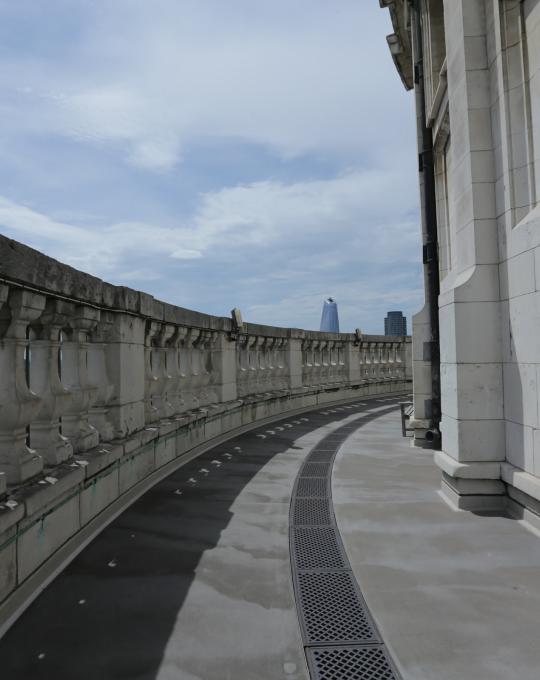
The Stone Gallery
The Stone Gallery is the first of two galleries above the Whispering Gallery that encircle the outside of the Dome. The Stone Gallery stands 52 metres above ground level and can be reached by 376 steps.
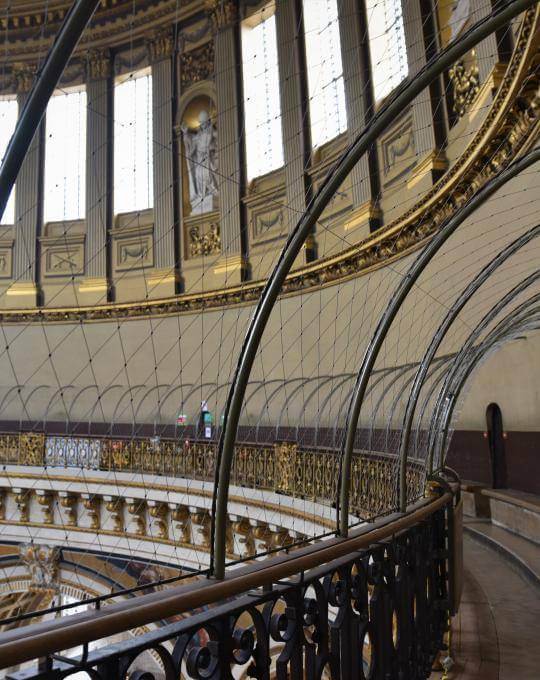
Whispering Gallery
Climb up 257 steps from the Cathedral floor and you will find the Whispering Gallery, which runs around the interior of the Dome. It gets its name from a charming quirk in its construction, which makes a whisper against its walls audible on the opposite side.
The Dome
Explore the Galleries during your visit.
*Please note that the Galleries can be accessed by stairs only. There are a total of 257 steps to the Whispering Gallery, 376 steps up to the Stone Gallery and 528 steps (total) to the Golden Gallery. We recommend that those with pre-existing medical conditions, mobility difficulties or concerns with heights and confined spaces do not try to climb these stairs.
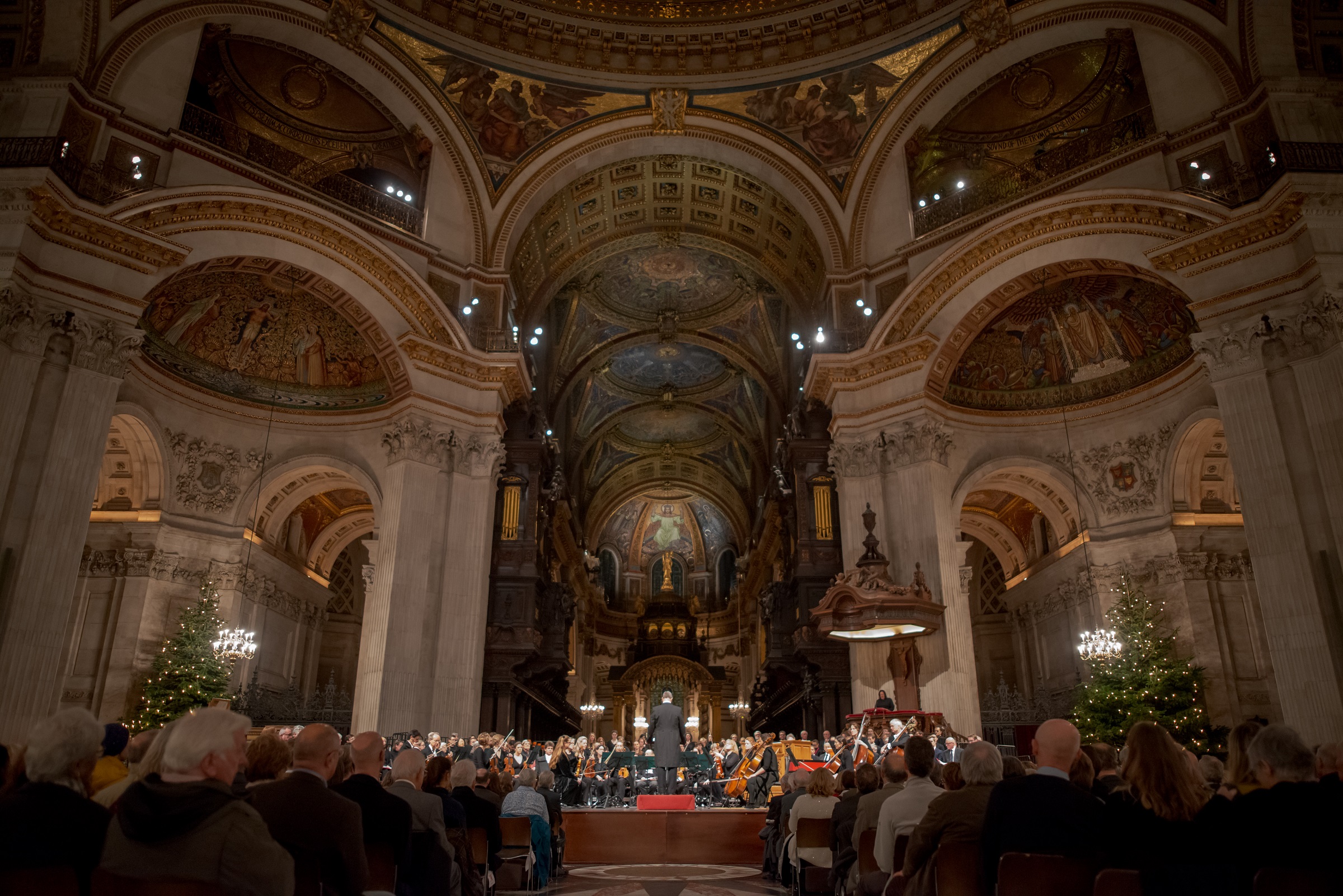
Book your tickets
On our booking page, you'll find information about our various sightseeing tickets, including what discounts are available for families, groups, concessions and more. You can also book Triforium tours and guidebooks via our online booking portal.





